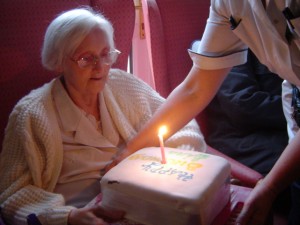Today SevenPonds is speaking with Julie Groves, owner of the occupational therapy organization Therapy In Your Home in the San Francisco Bay Area. Julie has been working in the field of home care since 1980, including experience in working in hospitals and rehabilitation facilities.

Credit: http://therapyinyourhome.net/
Kimberly: Can you give us an idea of how you work with geriatric doctors to fulfill care plans?
Julie: Sometimes the doctor says, “This person isn’t functioning well; see what you can do to help.” Sometimes the doctor gives us more specific details like, “this person has a bad shoulder; See what you can do to help.” So it depends on what needs the doctor sees.
Usually we go back to the doctor and tell them what the problem is, what is causing it and our recommendations. Then we get an okay from the doctor for what we are going to do and we continue to keep them informed. We help the client advocate for themselves a lot as well to make sure that they can tell their needs to the doctors.
Kimberly: Do you have any stories for how occupational therapy has positively affected your clients’ lives?
Julie: For instance, a daughter in New York will call us when she is worried about her mother. She’ll say that she is worried about what her mom is doing and if she needs to be doing more, and we can report with the daughter that her mom really does need more help, or we can report back that she is taking steps to do well, like calling her friend every night and going out regularly.
Another situation would be a son that is hurting his back every night getting his mother out of bed. He may not realize that he doesn’t need to use all of his physical strength to lift his mom up and down. Mom can help some too, which is better for mom and better for his back.
Maybe a wife and a patient are at odds with each other over a new diagnosis of Parkinson’s, where one doesn’t feel that they are helping enough and the other isn’t feeling that they are listening to their needs. We can help them work through this to make Parkinson’s the main problem rather than their conflict with each other.

Credit: Wikipedia
Kimberly: Are there any common questions you get when you meet with people for the first time?
Julie: The questions people always ask are: “How much does it pay?”; “Will there be any jobs?”; “How is it different than a physical trainer?”; “How is it different from nursing?”. The answer to how it’s different from nursing is that nursing is more about taking care of the person and OT (occupational therapy) is more about helping people change. That’s not so true anymore, but there used to be quite a difference in what would go into being an OT versus what goes into nursing. Now the answer to these questions determines what area of nursing or OT you will go in to.
Kimberly: Do you spend a lot of time with patients in their homes?
Julie: Yes. A visit tends to be an hour and it’s not just talking about things, it’s actually doing things and watching the patient and the caregiver. If you’re working with kids, it’s also helping them do the tasks that improve posture and sensitivity and coordination.
Kimberly: Are there services or plans that you more commonly offer to clients at the end of their lives.
Julie: Most hospices don’t have therapists on staff. Some hospices around here will pay for us to come in and provide therapy to their clients. For specific instruction, like teaching a person how to get out of bed more easily, teaching the families what an appropriate level of exercise is for that person, or helping them figure out whether it’s still appropriate for them to be going to the bathroom by themselves or whether they should be supervised. There are very specific instructions that it just takes about one visit to clarify to the family what needs to be done.
The questions we usually ask are “Is it safe?”; “Do you know what to do when something happens on a bad day or when there is a decline in function?”; “How can you help the person in hospice to feel safe and comfortable?”.
Kimberly: Do you also offer cognitive exercises that can help with your clients?

Credit: Wikipedia
Julie: Anxiety is such a common problem for the young and the old. Almost routinely, we get feedback about how they are responding to frustration, fear, having a caregiver, NOT having a caregiver. We’re responding to this feedback and teaching them to remember to breathe, to take time out for themselves, to use mental hygiene techniques, just like they use physical hygiene techniques.
Julie’s 4 Mental Hygiene Tips
1. Be aware of what those feelings are. Frustration, loneliness, fear. Stay with the turmoil and think about it.
2. Notice how it affects your body.
3. Do you have to frame the question this way, or is there a different perspective?
4. Know that your physical help is dependent on your mental health, and your mental health is dependent on your physical health. Get enough sleep, drink enough water and move.
Kimberly: So this is more analytical than meditative?
Julie: Yes. Meditation will guide them to this way, and it works for those who already believe. But sometimes you have to take people to that point to get them to believe and change their lives. That’s why occupational therapists work on those two aspects, rather than a physical therapist, who may work on physical exercise. And 90% of my calls are asking for a physical therapist, where an OT may be more appropriate to help them start doing the exercises that they may already have gotten from other therapists and doctors.
Kimberly: Do you have any advice for family members who are taking care of a loved one that can benefit from occupational therapy?
Julie: First, ask yourself if you even have time or the bandwidth to have one more person come in and tell you what to do. You may be overwhelmed, but that also may mean that you need to have someone come in and help you figure out what things you need to cut back on and what things you can do.
Kimberly: Thank you!
Julie: Thank you.
Read Part One of this interview here!

 What is Occupational Therapy? An Interview with Julie Groves, Part Two
What is Occupational Therapy? An Interview with Julie Groves, Part Two


 Passing of Beloved Comedian Births a New Comedy Festival
Passing of Beloved Comedian Births a New Comedy Festival

 The Spiritual Symbolism of Cardinals
The Spiritual Symbolism of Cardinals














